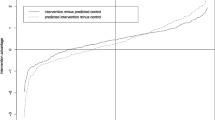Abstract
The practical implementation of evidence-based prevention programmes is a major challenge that requires a sound scientific basis. This paper refers to statistical aspects that are relevant in the planning phase of a primary prevention programme. First, a stepwise approach using graphical models and CHAID decision trees is presented to select subgroups of the population suitable for targeted intervention. Second, adequate statistical methods for sample size determination and for outcome evaluation to be used in the planning phase of a study are described. The IDEFICS project is presented as an example to illustrate the way leading from the aetiology of a disease to the design of a primary prevention programme, its implementation and its evaluation. The practical implications of the presented approaches and their methodological caveats are discussed.





Similar content being viewed by others
References
Ahrens W, Bammann K, de Henauw S, Halford J, Palou A, Pigeot I, Siani A, Sjöström M; IDEFICS Consortium (2006) Understanding and preventing childhood obesity and related disorders-IDEFICS: a European multilevel epidemiological approach. Nutr Metab Cardiovasc Dis 16:302–308
Arbeitsgemeinschaft der Spitzenverbände der Krankenkassen (2006) Gemeinsame und einheitliche handlungsfelder und kriterien der spitzenverbände der krankenkassen zur umsetzung von § 20 Abs. 1 und 2 SGB V vom 21. Juni 2000 in der fassung vom 10. Februar 2006, p. 14f, http://www.bvgesundheit.de/pdf/leitfaden_praevention_2006b.pdf (accessed July 24, 2006)
Bammann J, Peplies J, Sjöström M, Lissner L, de Henauw S, Galli C, Iacoviello L, Krogh V, Marild S, Pigeot I, Pitsiladis Y, Pohlabeln H, Reisch L, Siani A, Ahrens W; IDEFICS Consortium (2006) Assessment of diet, physical activity, biological, social and environmental factors in a multi-centre European project on diet- and lifestyle-related disorders in children (IDEFICS). To be published in J Public Health
Bundeszentrale für gesundheitliche Aufklärung (2005) Kriterien guter praxis in der gesundheitsförderung bei sozial benachteiligten. BZgA, Köln. http://www.infodienst.bzga.de/medien/01_2006/konkret.pdf (accessed July 24, 2006)
Cloetta B, Spörri-Fahrni A, Spencer B, Ackermann G, Broesskamp-Stone U, Ruckstuhl B (2005) Anleitung zum ergebnismodell von gesundheitsförderung schweiz. modell zur typisierung von ergebnissen der gesundheitsförderung und prävention, 2nd edn. Gesundheitsförderung Schweiz, Bern, URL: http://www.gesundheitsfoerderung.ch/common/files/knowhow/tools/N107713_Ergebnismodell_de.pdf (accessed July 24, 2006)
Cohen J (1988) Statistical power analysis for the behavioural sciences, 2nd edn. Lawrence Erlbaum, Hillsdale New Jersey
Edwards D (2000) Introduction to graphical modelling, 2nd edn. Springer, Berlin Heidelberg New York
Hawkins DM, Kass GV (1982) Automatic interaction detection. In: Hawkins DM (ed) Topics in applied multivariate analysis. Cambridge Univ Press, Cambridge, pp 267–302
Jahn I, Foraita R, Pohlabeln H (2006) Rauchen, gewicht, bewegung, früherkennung. Zielgruppen für prävention und gesundheitsförderung im land bremen. http://217.110.205.153/private/aktuell/rubrik_set552.htm?artikel7925.htm (accessed July 24, 2006)
Kass GV (1980) An exploratory technique for investigating large quantities of categorical data. Appl Stat 29:119–127
Lemeshow S, Hosmer DW, Klar J, Lwanga SK (1990) Adequacy of sample size in health studies. Wiley, Baffins Lane Chichester West Sussex
Lenth RV (2001) Some practical guidelines for effective sample-size determination. Am Stat 55:187–193
Machin D, Campbell MJ (1987) Statistical tables for the design of clinical trials. Blackwell, Oxford
Robinson TN (1999) Reducing children’s television viewing to prevent obesity. A randomized controlled trial. JAMA 282:1561–1567
Rosnow RL, Rosenthal R (1996) Computing contrasts, effect sizes, and counternulls on other people’s published data: general procedures for research consumers. Psychol Methods 1:331–340
Walker GA (2002) Common statistical methods for clinical research with SAS examples, 2nd edn. SAS Publishung, Cary
Wikipedia contributors (2006) “Education in Germany”, Wikipedia, The Free Encyclopedia, http://en.wikipedia.org/w/index.php?title=Education_in_Germany and oldid=65461896 (accessed July 24, 2006)
Acknowledgement
The authors would like to thank an anonymous referee for his/her comments that improve the coherence of the paper. We thank the Bremen State Ministry of Labour, Women’s Rights, Health, Youth and Social Affairs for partially funding the analysis of the Bremen survey GESUNDHEIT!. Part of this work was done as part of the IDEFICS Project (http://www.idefics.eu). We gratefully acknowledge the financial support of the European Community within the Sixth RTD Framework Programme Contract No. 016181 (FOOD). The information in this document reflects the authors’ views and is provided as is. No guarantee or warranty is given that the information is fit for any particular purpose. The users thereof use the information at their sole risk and liability.
Conflict of interest statement
The authors have disclosed any relevant associations that might pose a conflict of interest.
Author information
Authors and Affiliations
Corresponding author
Rights and permissions
About this article
Cite this article
Pigeot, I., Ahrens, W., Foraita, R. et al. Sample selection and outcome evaluation in primary prevention. J Public Health 15, 93–99 (2007). https://doi.org/10.1007/s10389-006-0087-8
Received:
Accepted:
Published:
Issue Date:
DOI: https://doi.org/10.1007/s10389-006-0087-8




